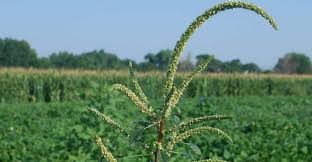Spring is in the air! The grass is greening up, the songbirds are back serenading us, each day is getting longer, the daily temperature is sort of warming up, and snow is changing to rain (for the most part). But that is the problem, isn’t it? Temps are staying lower than average, and the precipitation does not seem to want to stay away for longer than a 48-hour stretch, at best. In Champaign, the average temperature for the month of April so... Read More →
ILSOYADVISOR POST
Take Your Seeds Off Before Entering
August 30, 2018
Common manners suggest that you remove your shoes before entering someone’s home as a guest. Does this etiquette apply to entering a farmer’s field?
During a recent scouting day, I encountered an area of Palmer amaranth next to a field I was exiting. If you don’t already know it, Palmer is our next big weed challenge. And if you thought controlling waterhemp was tough—Palmer is even tougher.
As I observed the population of weeds in the soybean field, I decided to get a closer look and walk along the ditch to see if it was truly Palmer amaranth. A quick reference to a Palmer amaranth ID guide reminded me to look for:
- Leaves oval to diamond shape
- Petioles as long, or longer than the leaf blade
- Main seed head as long as the arm
- Prickly seeds

After quickly checking all these characteristics I acknowledged it was indeed a large population of Palmer amaranth. Having learned about this problematic weed at field days and from Southern U.S. growers’ horror stories, I was surprised to stumble upon it in a local Illinois soybean field.
According to the Purdue Management Guide, when Palmer amaranth is identified in a field, control recommendations include multiple approaches. Since Palmer species are assumed to be both glyphosate- and ALS-resistant, and recognized as an aggressive and adaptive weed, utilizing a combination both cultural (including hand rogueing) and herbicide control practices are recommended. After seeing this dense patch of Palmer amaranth in a field and scattered along the road ditch it was obvious this population has been difficult to control.
As I continued scouting fields miles away, I noticed several prickly seeds stuck to the sole of my boots and a few in the floormat of my vehicle. Not having experience around Palmer amaranth, I didn’t expect seeds would be so easy to acquire. I quickly removed them and paused to consider how even I could move this problematic weed across counties so easily. My concern for this simple mistake led me to consider how this weed is being spread by movement of farm equipment and many other avenues.
As harvest approaches and equipment begins to move, take the time to clean any equipment before travelling between farms and fields to slow the spread of this and other problematic weeds. And if you observed any Palmer amaranth in your fields and herbicides didn’t control them, make sure you remove them from the field by hand before they contribute to your weed seed bank.





Comments
Add new comment